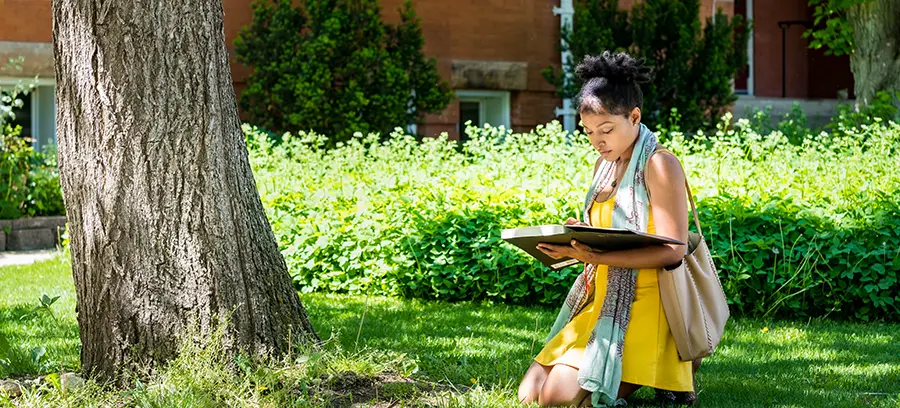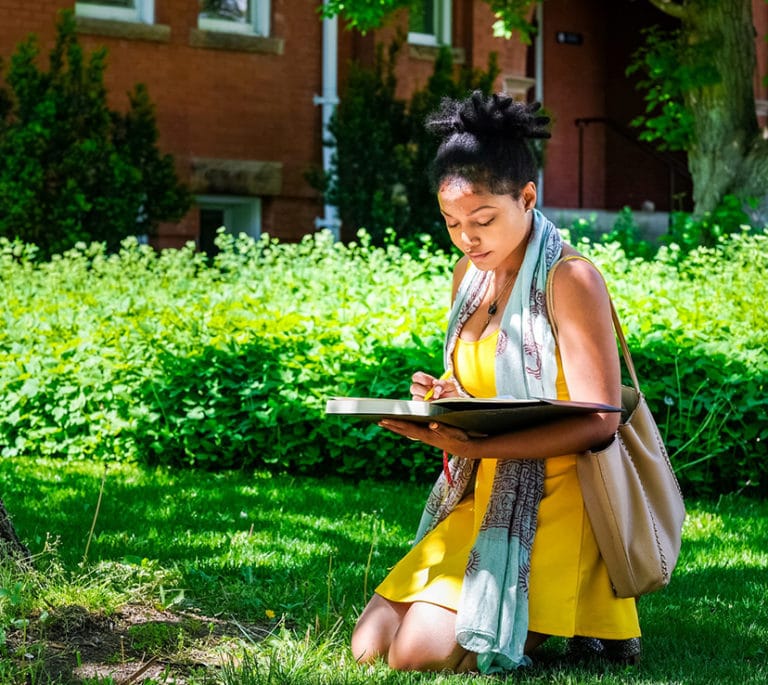Contemplative Art: Window Shopping Practices
With Robert Spellman
Introduction
The contemplative art practice Window Shopping I & II are exercises in composition that develop a new way of seeing. We are directed to pay attention to the “mere” shape and color of what we see, devoid from the stories, ideas and concepts we may have about an image. Requiring no prior training and using “pleasure as our guide,” we uncover our inherent aesthetic sensibility.
The purpose of this exercise is to provide a relaxed opportunity for observing moments of artistic decision. The means are kept simple to avoid the impediments that arise from conceptual complication or technical deficiencies. It also offers a microcosm of artistic propensity, a view into one’s own leanings and pleasures, and opens up a surprising abundance of artistic source material.
Historical Background and Lineage
This practice draws from Robert Spellman’s study of art and Buddhist practice. In the Buddhist teachings, our visual experience is seen as being just shape, texture and color. The ideas, emotions and stories we may have about what we see are secondary and not identical to the visual experience itself. This practice invites us to experience the more fundamental, primary quality of seeing.
About Professor Robert Spellman
Robert taught in the Visual Arts, MFA Theater, and Religious Studies programs at Naropa University. He has worked as a painter, graphic designer, illustrator, piano re-builder, and musician. His work is exhibited nationally and internationally and appears in numerous publications. Robert has practiced and taught Buddhist meditation for forty years. He was director of Dorje Khyung Dzong, a rural retreat center, and Karma Dzong, an urban meditation center in Boulder, Colorado. He is also co-founder of Mountain Water, an artist’s retreat in the wilds of southern Colorado. Visit his website at robertspellman.com.
Benefits of this Practice
- Fosters a new way of seeing and exploring our visual world
- Works with non-conceptual mind
- Encourages curiosity about where and how the process of creativity takes place, as it is happening
- Unveils our innate aesthetic sensibility for composition
- Develops confidence in individual choices and decisions
- “Mines” images from current culture and brings a new view to them
Preparations for Teaching
- Practice this exercise yourself with a partner several times, journal and reflect on what you have gained from it, so that you can bring your personal experience to bear on the practice as you offer it in class.
- Reflect on where in your syllabus you want to situate the practice. Perhaps half-way through the semester this practice can infuse new perspectives.
Steps for Teaching
- Create a conducive environment to introducing contemplative practice. Explain the reasons and benefits for contemplative practices in general and for this one in particular (see above for some of the benefits students have reported).
- We recommend letting the class know that there will be a discussion about the practice and that students will have a chance to share their experiences afterwards. This can help students go deeper into the practice.
Window shopping I
1. Materials
One sheet of 8 ½” x 11 white card stock with a window, approximately 1 ½” x 1 ½” cut carefully into the center area. A fine felt tip or ballpoint pen, or pointed pencil. Scissors or Xacto® knife. Glue stick or paste. A magazine with lots of color advertisements and pictures.
2. Instructions
Using your prepared window, explore the pages of magazines for colors, shapes and textures that attract your attention. This could be – and often is – guided by the simple experience of pleasure. Avoid content such as printed words, letters, symbols, or recognizable elements that might trigger verbal categories or steer toward conceptual “meaning”. Do this lightly, without cleverness or suspicion. Mark out squares that please you and cut them out. Find many of them, at least two dozen. The next step is to make arrangements of two squares each, using the same criteria as above. Paste the two side-by-side, touching and meant to be viewed horizontally.
Note:
In the Contemplative Artist class this exercise is presented in conjunction with mindfulness meditation: the experience of recognizing a composition as described here is enhanced by the practice of paying relaxed attention to moment-to-moment experience.
Window shopping II
1. Materials
One sheet of 8 ½” x 11 white card stock with a window, approximately
1 ½” x 1 ½” cut carefully into the center area. A fine felt tip or ball-point pen, or pointed pencil. Scissors or Xacto knife. Glue stick or paste. A magazine with lots of color advertisements and pictures.
2. Instructions
As with the Window Shopping I exercise, use your prepared window to explore the pages of magazines for colors, shapes and textures that attract your attention. This could be – and often is – guided by the simple experience of pleasure. In the first exercise we made a point of avoiding recognizable images or literal content of any kind. For this exercise you can allow images and recognizable content into the squares. As before, do this lightly, without cleverness. In this exercise resist the urge to inject specific “meaning” into the squares; it will find its way in without our bossing. “Recognizable content” could be quite subtle; feel free to explore the twilight area between what it recognizable and what is not. Mark out squares that please or surprise you and cut them out. Find many of them, at least two dozen. Make arrangements of two squares each, using the same criteria as before. Paste the two side-by-side, abutting each other and meant to be viewed horizontally.
3. Purpose
The purpose of this second Window Shopping exercise is to venture into the realm of recognizable content and literal association. It is possible to do this with the same uncomplicated mind as before, guided by simple self-arising recognition. This, too, offers a microcosm of artistic propensity, a view into one’s own leanings and pleasures. It also demonstrates the surprising abundance of artistic source material.
Note:
In the Contemplative Artist class students do the Window Shopping I & II exercises in two consecutive weeks. They then write a short paper describing the experience and any observed differences between the first and the second iterations. Most students find themselves at home in one or the other of the two versions, which seem to highlight different cognitive functions. The first being strictly visual the second tending toward verbal.
Closing Notes for the Teacher
- Facilitate a discussion of the practice, inviting students to share their experiences of and responses to the practice. What was noticed before, during, or just after? Was there a sense of something developing? Robert Spellman says students are often surprised at the result and how two seemingly disparate images relate to each other in an aesthetically pleasing way.
- The practice can be further enhanced by investigating scale: scan and project the images, or window “dyads”, onto a large screen so the image is about four by eight feet.





